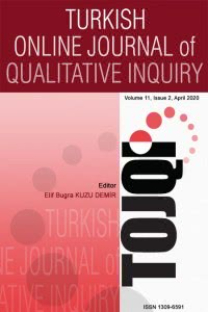Use of Educational Movies in Classroom Management Courses: A Metaphorical Study
Sınıf Yönetimi Derslerinde Eğitim Konulu Filmlerin Kullanılması: Metaforik Bir Çalışma
___
Akıncı-Yüksel, N. A. (2015). Kültürel bir film olarak Türkiye’de sinema filmlerinde okul, öğretmen ve öğrenci temsilleri. Global Media Journal TR Edition, 6(11), 1-17.Altan, M. Z. (2016). Öğretmenliğe dair, filmler ve öğretmenler. Ankara: Pegem Akademi.
Arroio, A. (2010). Context based learning: a role for cinema in science education. Science Education International, 21(3), 131-143.
Birkök, M. C. (2008). Bir toplumsallaştırma aracı olarak eğitimde alternatif medya kullanımı: sinema filmleri. Uluslararası İnsani Bilimler Dergisi, 5(2), 1-12.
Champoux, J. E. (1999). Film as a teaching resource. Journal of Management Inquiry, 8(2), 206-217.
Christensen, L.B., Johnson, R.B., & Turner, L.A. (2015). Nitel ve karma yöntem araştırmaları In M. Sever (Trans.), A. Aypay, (Trans. Ed.), Araştırma yöntemleri desen ve analiz (pp. 400-433). Ankara: Anı.
Creswell, J.W. (2013). Nitel araştırma yöntemleri beş yaklaşıma göre nitel araştırma ve araştırma deseni. Ankara: Siyasal Kitapevi.
Demirtaş, M. (2011). Halkla ilişkiler filmleri ve halkla ilişkiler filmlerinde öncüler: ABD ve Almanya örneği. İstanbul Aydın Üniversitesi Sosyal Bilimler Dergisi, 3(9), 34-52.
English, F.W., & Steffy, B.E. (1997). Using film to leadership in educational administration. Educational Administration Quarterly, 33(1), 107-115.
Fennell, H.A. (2013). Reel stories of teaching: film and teacher education. Action in Teacher Education (Association of Teacher Educators), 35(5-6), 445-461. doi: 10.1080/01626620.2013.846762.
Fisch, S.M., Yotive, W., McCann, S.K., Scott, M., & Chen, L. (1997). Science in Saturday morning: children’s perceptions of science in educational and non-educational cartoons. Journal Educational Media, 23, 157-167.
Girgin, M. (2017). Eğitim filmleri. Ankara: Vize.
Hesapçıoğlu, M. (2008). Ders araçları.In Öğretim ilke ve yöntemleri (pp. 405-490). Ankara: Nobel.
Huczynski, A., & Buchanan, D. (2004). Theory from fiction: A narrative process perspective on the pedagogic use of feature films. Journal of Management Education, 28, 702-726.
Kaşyaka, A. (2013). Okul ve Öğretmen Içerikli Sinema Filmlerinin Öğretmen Adaylarının Pedagojik Inançları ve Eleştirel Yansıtma Becerileri Üzerine Etkisi. (Yayımlanmamış Doktora Tezi), Gazi Üniversitesi Eğitim Bilimleri Enstitüsü, Ankara.
Kaşyaka, A., Ünlü, İ., Akar, M. S., & Özturan-Sağırlı M. (2011). Okul ve öğretmen içerikli sinema filmlerinin öğretmen adaylarının mesleki tutumlarına ve özyeterlik algılarına etkisi. Kuram ve Uygulamada Eğitim Bilimleri, 11(4), 1765-1783.
Kavan, H., & Burne, J. (2009). Using film to teach communication concepts at university. The International Journal of Learning, 16(10), 429-440.
Kaya, Z. (2006). Öğretim teknolojileri ve materyal geliştirme. Ankara: Pegem Akademi.
Kontaş, H. (2016). The effect of an education-theme movie on academic motivation of teacher candidates and their attitude towards teaching profession. Journal of Education and training studies, 4(6), 93-103
MacDonald, D. (1999). Teacher attrition: a rewiev of literatüre. Teaching and Teacher Education, 15(8), 835-848.
Millî Eğitim Bakanlığı [MEB] (2017). Öğretmenlerin 2017 Eylül Dönemi Mesleki Gelişim Çalışmaları. Retrieved May 7, 2018, from https://oygm.meb.gov.tr/meb_iys_dosyalar/2017_08/28191925_EK_Mesleki_YalYY malar_ProgramY_EylYl_2017.pdf
Neuman, W. L. (2010). Toplumsal araştırma yöntemleri nitel ve nicel yaklaşımlar (4. Baskı) (S. Özge, Çev). İstanbul: Yayın odası.
Nevil, S. A. (2012). Teachers’ Perspectives on Use of Movies in the Social Studies Classroom. (Unpublished Master’s Thesis). Ohio University, USA.
Oruç, Ş., & Sarıbudak, D. (2015). Okul yöneticilerinin ve öğretmenlerin eğitim içerikli filmlerin eğitim ortamlarına etkisine ilişkin görüşleri. International Journal of Field Education, 1(1), 19-41.
Silman, F. (2017). Eğitim konulu filmler. Ankara: Pegem Akademi.
Strauss, A., & Corbin, J. M. (1990). Basic of qualitative research: Grounded theory procedures and techniques. Sage Publications, Inc.
Tan, C. (2006). Philosophical reflections from the silver screen; using films o promote reflection in pre-service teachers. Reflective Practice, 7(4), 483-497.
Tofur, S. (2017). ‘Hababam Sınıfı’ filmi ilk serisinin Katz’ın yönetsel üç beceri yaklaşımına göre incelenmesi. The Journal of Academic Social Science Studies, 56, 53-66. doi:10.9761/JASSS7048
Tofur, S. (2018a). Case of a Classroom Management Model in Cinematographic Narration: The Movie ‘Stand and Deliver. International Online Journal of Educational Sciences, 10(2), 146-161. doi:10.15345/iojes.2018.02.010
Tofur, S. (2018b). Sinematografik anlatıda okuldaki iletişim ağları: Ron Clark’ın hikayesi filmi örneği. Eğitim Kuram ve Uygulama Araştırmaları Dergisi, 4(1), 54-67.
Tofur, S. (2018c). Sinematografik anlatıda Hersey-Blanchard durumsal liderlik modeli: Koro filmi. Kuramsal Eğitimbilim Dergisi, 11(4), 822-837. doi:10.30831/akukeg.399319
Wegner, H. (1977). Teaching with film. Indiana: Phi Delta Kappa Educational Foundation Bloomington.
Wiater, W. (1999). Von schüler her unterrichten. Eine neue didaktik für eine veränderte schule. Auer: Donaunurörth.
Yurdigül, A. (2014). Eğitim olgusunun sinematografik anlatıdaki yeri üzerine bir yaklaşım denemesi (‘Bal’ filmi örneği). Ekev Akademi Dergisi, 18(60), 487-502.
Yıldırım, A., & Şimşek, H. (2008). Sosyal bilimlerde nitel araştırma yöntemleri (6. Baskı). Ankara: Seçkin.
Akad, Ö. L. (Director), (1949). Vurun kahpeye [Motion picture]. Turkey: Erman film.
Barratier, C. (Director), (2004). Les choristes [Motion picture]. France: Vega film.
Bhansali, S. L. (Director), (2005). Black [Motion picture]. India: Applause Bhansali Productions.
Cantet, L. (Director), (2008). The class/Entre les murs [Motion picture]. France: Haut et Court.
Chadwick, J. (Director), (2010). The first grader [Motion picture]. England: Sixth Sense Productions.
Doğan, Ö., & Eskiköy, O. (Directors), (2008). İki dil bir bavul [Motion picture]. Turkey/Netherlands: Tiglon.
Eğilmez, E. (Director), (1975). Hababam sınıfı [Motion picture]. Turkey: Arzu Film.
Eğilmez, E. (Director), (1976). Hababam sınıfı sınıfta kaldı [Motion picture]. Turkey: Arzu film.
Falardeau, P. (Director), (2011). Monsieur Lazhar [Motion picture]. Canada: Micro_scope.
Fleck, R. (Director), (2006). Half Nelson. [Motion picture]. United States: Think film.
Herek, S. (Director), (1995). Mr. Holland’s Opus [Motion picture]. United States: Hollywood Pictures.
Hirani, R. (Director), (2009). 3 Idiots [Motion picture]. India: Vinod Chopra Productions.
Khan, A., & Gupte, A. (Directors), (2007). Taare zameen par [Motion picture]. India: Aamir Khan Productions.
LaGravense, R. (Director), (2007). Freedom writers [Motion picture]. United States: Paramount Picture.
Weir, P. (Director), (1989). Dead poets society [Motion picture]. United States: Touchstones Pictures.
- ISSN: 1309-6591
- Yayın Aralığı: 4
- Başlangıç: 2010
- Yayıncı: Prof.Dr. Abdullah Kuzu
ORKİDE BAKALIM, Faika ŞANAL KARAHAN, Gözde ŞENSOY
Zehra Saadet Fırat, Çağlayan Dinçer
Zehra Saadet FIRAT, Çağlayan DİNÇER
Sınıf Yönetimi Derslerinde Eğitim Konulu Filmlerin Kullanılması: Metaforik Bir Çalışma
Gönüllülük: Topluma Hizmet Uygulamaları Dersinin Değerlendirilmesi
Orkide Bakalım, Faika Şanal Karahan, Gözde Şensoy
Volunteering: Evaluation of Community Service Learning Program
Use of Educational Movies in Classroom Management Courses: A Metaphorical Study
